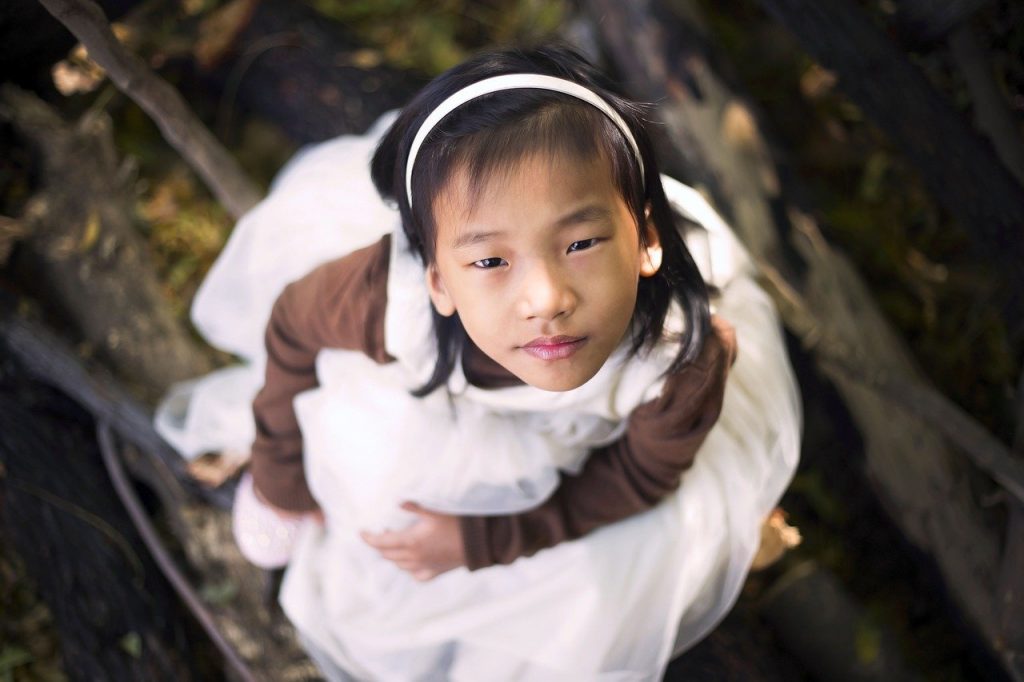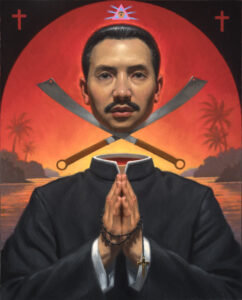She was a little Chinese Catholic girl, in a country where Catholics were and are only a demographic drop in the most populous country in the world, a country where Christians have been regarded for more than 100 years as dupes at best, agents at worst, of imperialistic Western powers. Their churches were marked for obliteration.
The little Catholic girl has been given a name—Li—but we don’t know if that was really her name. In several versions of the story she has no name at all. We don’t know exactly where in China she lived, either, perhaps the rural setting near Shanghai that is sometimes mentioned. Her age is usually given as 10 or 11, but we don’t really know about that, either. We know she lived in the twentieth century, and there is a strong likelihood that it was the mid-twentieth century, right after Mao Zedong completed his communist takeover of China.
Little Li never made it to adolescence; she was killed for her faith right in her village parish church. She has become a legend. Like so many of the early martyrs of the Church, she was a real soul whose story was taken up by other real souls looking for reasons to believe. Her story has been told, retold, and embellished by many tellers in an age hungry for faith, in a culture where terror and poverty have often reigned together, in a world riven by world wars, holocausts, and new weapons of mass destruction.
Many of the facts are uncertain except the most important one: Little Li—let’s call her that—was a martyr of the Eucharist. She gave her life in an act of Christian heroism and devotion to the Eucharist that has inspired multitudes.
What would you do if you were a Catholic and government troops invaded your parish church, imprisoning your parish priest? What would you do if the soldiers broke into the tabernacle, took the ciborium, and scattered the Hosts on the floor in an act of desecration designed to both terrorize you and demoralize you, to threaten everything and everyone you knew and loved?
What would you do? Many people under such pressure buckled and joined the secularizing majority.
Here is what Li did: After nightfall, she slipped back into the church and observed a Holy Hour in front of the Hosts scattered on the church floor. After she finished the devotion, she carefully bent down and consumed just a single one of the Hosts with her tongue.
As a layperson in those pre-Vatican II days, little Li had been taught it was wrong to touch the Host with her hands. And she knew that in ordinary circumstances lay people were not supposed to consume more than one Host in a day. (She didn’t know of the exception granted to prevent the desecration of the Eucharist.)
So, at great risk each time, Li patiently returned to the church night after night to observe her Holy Hour and consume another precious piece of the Body of Christ. There were 32 Hosts on the floor, so her nightly visits took just over a month. On the very last night, she was caught by a soldier guarding the church and killed.
The story of little Li became associated with Archbishop Fulton J. Sheen, the Catholic media personality whose television show, “Life Is Worth Living,” drew as many as thirty million weekly viewers during the 1950s. Sheen was a tireless promoter of the Holy Hour as a Catholic devotion.
In his autobiography, Treasure in Clay, completed shortly before his death in 1979 at age 84 but not published until 1982, Sheen wrote about the sufferings of Chinese Catholics in the wake of Mao’s revolution that established a Communist regime in China that has lasted to this day. Sheen wrote this:
“Elsewhere in China, a priest had just begun Mass when Communists entered and arrested him and made him a prisoner in a house adjoining the little church. From a window in that house he could see the tabernacle. Shortly after his imprisonment, the Communists opened the tabernacle, threw the Hosts on the floor, and stole the Sacred Vessels. The priest then decided to make adoration to Our Lord in the Blessed Sacrament as much as he could day and night. About three o’clock one morning, he saw a child who had been at the morning Mass open a window, climb in, come to the sanctuary floor, get down on both knees, press her tongue to the Host to give herself Holy Communion. The priest told me there were about thirty Hosts in the ciborium. Every single night she came at the same time until there was only one Host left. As she pressed her tongue to receive the Body of Christ, a shot rang out. A Communist soldier had seen her. It proved to be her Viaticum.”
According to people who knew Sheen or knew his work, this was an incident that Sheen had repeated in talks and interviews during his long priestly and media ministry. In particular, they say, Sheen had revealed in a 1979 television interview that little Li’s fervent devotion to the Eucharist had been the inspiration for his preaching. It was her story as well, according to accounts, that had led Sheen to promise that he, personally, would observe a Holy Hour of prayer and adoration before the Blessed Sacrament every day of his priestly life, a promise that he kept.
But there are inconsistencies: the tale of little Li has acquired a number of variants and likely grown in its many retellings.
For example, many—including Sheen himself in his autobiography—assume that Li was one of the first victims of Communism in China. There is a version of her story on the website of the Cardinal Kung Foundation, established to honor Ignatius Kung Pin-Mei (1901-2000), the long-imprisoned bishop of Shanghai, and to call attention to the persecuted Catholics of China’s underground Church.
The Cardinal Kung version, which refers to Li only as “a little girl” age 11, places her martyrdom as occurring “when the communists took over China,” that is, it would seem, in 1948 or 1949. The Kung Foundation version jibes fairly closely to the version in Sheen’s autobiography, although it is more detailed. For example, it states that the little girl consumed exactly 32 Hosts (not “about thirty”) before being killed, and offers a different version of the manner of her death.
According to the Kung foundation, just after she had consumed the thirty-second and last Host, she accidentally made a noise that awakened the sleeping guard, who didn’t shoot her, but, rather, beat her to death with his rifle butt. Yet as in Sheen’s autobiography, the parish priest, who had been imprisoned inside his rectory by the Communists, watched the crime helplessly from his window.
In 1988 a German priest and prolific author of devotional works, Karl M. Harrer, crafted his own version of Li’s story in a book, Die schönsten eucharistischen Wunder (“The Most Beautiful Eucharistic Miracles”). In this telling of the story, which also occurs during the Communist takeover of 1949, four soldiers and their commander barge into the parish priest’s schoolhouse and force the children to take down the classroom’s crucifix, statues, and holy pictures, and dump them into the toilet. One little girl, unnamed, refuses. The commander orders the girl’s father to be summoned and the villagers herded into the parish church where they watch the Hosts (their exact number is not given) not only thrown onto the church floor by the soldiers who use their rifles to pry open the tabernacle, but stomped on by them while their commander mocks the Real Presence.
The priest is imprisoned, not in his rectory as in the Cardinal Kung version, but in a coal bin inside the church that has a small opening through which he can see the unfolding events. He watches the little girl’s visits to the church—at dawn in this version, not at night–to pray and consume the Hosts on the floor. On the final day, as the girl is praying but before she has consumed the Host, the door of the church bursts open, and a soldier fires a single shot that mortally wounds her. With her last breaths the girl crawls to the Host, receives it, and then dies.
The soldier, shocked at his deed, frees the priest from the coal bin. He tells the priest, “Sir, if in every town there was such a little girl, no soldier would ever fight for the Communists!”
Harrer, who died in 1996, added to the story an apparent appearance of the Blessed Virgin—a “lovely young woman clad in beautiful garments” who enters the church and comforts the little girl after the soldiers’ commander abuses her, lending a miraculous element to the Little Li story.
The most elaborate version of the story appeared in a 2007 book by Sister Emmanuel Maillard, a consecrated lay member of the Community of the Beatitudes, a French charismatic organization, and a champion of alleged apparitions of the Blessed Virgin in Medjugorje. Sister Emmanuel’s retelling of the story in The Hidden Child of Medjugorje generally tracks Harrer’s, except that it is even more detailed. She gives a specific month and year for the martyrdom—July 1953, two months after the girl’s First Communion—and she is the first to attach the name “Li” to the little girl, whose age is 10 in her version. The parish priest also has a name: Father Luke from the “Missions Étrangères,” apparently a reference to a Paris-based missionary organization. There is also a nun, Sister Euphrasia, who teaches catechism to the village children at the parish school.
The indignities Li suffers are more drawn-out and detailed in this than in other versions. When she tries to hide a picture of the Good Shepherd from the soldiers confiscating the school’s holy images, their captain slaps her on the cheek and sends her crashing to the floor. The soldiers don’t break into the tabernacle with their rifles; they fire at it. The priest is neither imprisoned in the rectory as in Sheen’s autobiography and the Cardinal Kung version, nor locked in the coal bin as in Harrer’s. Rather, the parishioners hide him in a recess in the choir of the church, where, as in the other versions, he can see little Li praying and receiving the Host at daybreak for each of the 32 nights (Father Luke knows exactly how many Hosts he had placed in the ciborium).
The single gunshot that mortally wounds Li just before she consumes the last Host appears in Sister Emmanuel’s version, but she does not mention the mysterious lovely young woman who comforts Li in Harrer’s version.
The association of the story of little Li with the Communist takeover of China under Mao Zedong makes sense. Those years, especially after the Korean War broke out in 1950, were marked by brutal persecution of Christians as agents of foreign powers. Bishops and priests were arrested, imprisoned, tortured, and killed. Foreign missionaries were expelled, and Mao’s government launched a massive effort to break the independence of China’s Christian churches, including the Catholic Church, and bring them under direct government control.
One of the resisters was Ignatius Kung, arrested in 1955 and imprisoned for more than 30 years. He was secretly named a Cardinal in pectore by Pope St. John Paul II, his elevation revealed only in 1991. The story of Li’s heroism resonated in part because it exemplified that of Kung and many others.
But there is a chronological problem: the connection to Fulton J. Sheen. The late Father Andrew Apostoli, a Franciscan priest who was one of the postulators for Sheen’s canonization, offered a version of the story of little Li whose time frame actually contradicted that in Sheen’s own autobiography. Apostoli maintained that Sheen had heard the story of little Li while he was a student in seminary prior to his ordination in 1919. That would place Li’s martyrdom several decades earlier than Mao’s takeover, Apostoli concluded, perhaps during the 1911 Revolution that ended imperial rule in China, or during the Boxer Rebellion of around 1900. Both events were marked by extreme violence toward Christians both foreign and Chinese. “[I]t may not have been the communists who perpetrated this horrible crime,” Apostoli wrote in a foreword to St. Thérèse: A Treasured Love Story (2007), a collection of sermons preached by Sheen about the French Carmelite nun who had also inspired him.
Apostoli’s narrative about Sheen, however, has its own problems. Like others who have touched on the Li-Sheen connection, he does not provide a specific date for, much less a citation to a transcript of Sheen’s alleged televised statement in 1979, making it challenging to track down. As for Sheen’s having heard the story while he was studying for the priesthood from 1917-1919, Apostoli attributes that detail to a bishop (unnamed in his foreword) with whom he had spoken at an EWTN event: “The bishop told him that he had spoken with a seminary classmate of Sheen’s at St. Paul Seminary, who said he, Sheen, and another classmate heard the story while they were students there.”
This double hearsay is difficult to verify because of the anonymity of the sources, and it is likely that all the informants are dead, including, now, Apostoli himself, who died in December 2020. So in the absence of records or long memories in China, where the persecution of Christians continues, it seems impossible to know for certain exactly what the circumstances and timing of Li’s death were. Communist revolution or Boxer Rebellion? She remains shrouded in what appears to be impenetrable mystery.
Did Sheen, close to his death, misremember when he had heard the story of little Li—or did he conflate it with a similar story of Chinese Catholic heroism that had occurred earlier or later? On the other hand, perhaps Apostoli’s sources were mistaken.
This is something that the latest reteller of Li’s story, Ellen Lucey Prozell, a writer for Catholic magazines, candidly recognized. In 2016 she turned the story into a children’s book, 32 Days: A Story of Faith and Courage (Pauline Kids). Using some of the material on which Sister Emmanuel elaborated, Prozell added frankly fictional details, naming the little Chinese girl “Pei” and creating family members, friends, and a close-knit peasant village whose parish school is taken over by Mao’s revolutionaries, with the children forced to regurgitate Marxist doctrine after all the religious objects in their church and classrooms are destroyed. She builds in suspense: Pei is almost caught several times while sneaking into the church—and then caught for real in the book’s sad but inspiring ending.
The spare details that are known are what give the story of this child-martyr the feel of concrete truth: Thirty-two Hosts. What storyteller would make up such a seemingly arbitrary number? The desecrated church, the repeated acts of heroism based upon her child’s faith and devotion, a violent death in a country whose twentieth century (as well as its twenty-first) has been marked by brutal efforts to eradicate Christianity.
We don’t know Li’s actual name or exactly when she lived and died, but we can know the persecution she and millions endured and the faith that allowed Little Li to die a martyr for the Eucharist are both most assuredly real.
Author’s Update:
After this piece was posted I heard by email from Sister Connie Derby, R.S.M., archivist for the Archdiocese of Rochester, New York, where Fulton J. Sheen served as archbishop from 1966 to October 1969, when he resigned at age 74, ten years before his death on December 9, 1979. (I had also contacted archivists at the Diocese of Peoria, Illinois, where Sheen had been ordained in 1919, and St. Bernard’s School of Theology and Ministry in Rochester, which houses a large collection of Sheen’s papers.)
The Rochester archdiocesan archives contain extensive documentation, in print and on video, of Sheen’s career as bishop and media personality. I had asked Sister Connie whether the archives included any documentation of Sheen’s alleged statement in an interview shortly before his death that a little Chinese girl’s devotion and martyrdom had inspired his own devotion to the Holy Hour. Sister Connie sent me a copy of an interview given by Sheen to Long Island Catholic published on April 26, 1979, as well as a YouTube link to Sheen’s very last television interview, in October 1979. Neither contains any reference to little Li. Sister Connie told me that the YouTube video was “probably edited,” and so it is possible that Sheen could have mentioned Li elsewhere in the interview. “In the end, I can neither confirm nor deny that he mentioned this story in an interview,” Sister Connie emailed me. “I simply find no evidence for or against it in our files.”
Charlotte Allen is executive editor of Catholic Arts Today.




